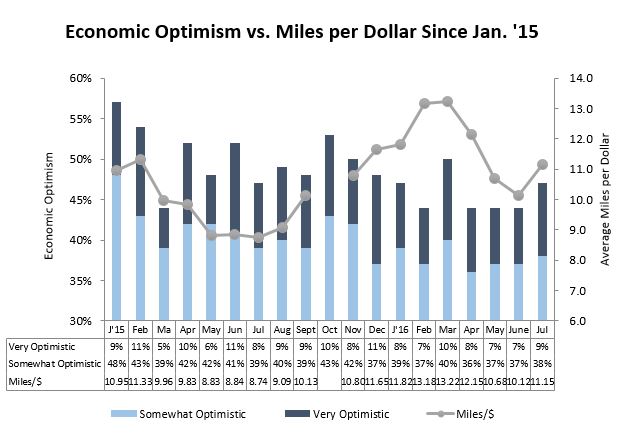FOR IMMEDIATE RELEASE
Contact: Jeff Lenard
July 12, 2016 (703) 518-4272
jlenard@nacsonline.com
ALEXANDRIA, Va. — Consumer optimism increased to its highest level since March as gas prices reversed a four-month climb and dropped 12 cents per gallon last month, according to the latest national consumer survey released by the National Association of Convenience Stores (NACS).
Overall consumer optimism about the U.S. economy increased three points to 47% in July, but there were significant demographic variations. Six in 10 younger consumers (60%) ages 18–34 say that they are optimistic, compared to only 37% of those ages 50 or older.
Gas prices remain much lower than they have been in recent summers. This month’s reported price of $2.26 per gallon is 53 cents lower than the reported price of $2.79 in July 2015. As gas prices have declined, U.S. fuel consumers are less likely to say that gas prices significantly affect their feelings about the economy. Just one in five (22%) of fuel consumers say gas prices have a “great impact” on their feelings about the economy, the lowest number since NACS began surveying in January 2013.
Not only are consumer less concerned about current prices, they also feel good about future price changes. Only four in 10 (41%) consumers expect gas prices to increase over the next 30 days, the lowest percentage since February. And they say that prices would have to reach an average of $4.71—more than double today’s prices—before they would consider alternatives to driving or significantly reduce the amount that they drive.
The boost in consumer optimism regarding the economy may not immediately translate into a boost for the economy. Only one in five consumers (20%) say they will drive more over the coming month and only one in six consumers (16%) say they will spend more money shopping at all retail locations this month. However, both percentages are in line with historical averages for the month.
Fuel efficiency may also play a role in optimism. Consumers say their vehicle’s average fuel efficiency increased to 25.2 miles per gallon, the highest level since NACS began conducting monthly consumer surveys in 2013. As a result, average miles per dollar—a calculation that examines gas prices related to vehicle fuel efficiency—increased to 11.2 miles per dollar.
“Monthly changes in gas prices clearly affect consumer sentiment. The question is how much any future price drops can push optimism higher at a time when consumers still have broader political concerns, especially as the national conventions loom,” said Jeff Lenard, NACS vice president of strategic industry initiatives.
NACS, which represents the convenience store industry that sells 80% of the gas in the United States, conducts monthly consumer surveys to gauge how gas prices affect broader economic trends. The survey was conducted online by Penn Schoen Berland; 1,101 U.S. adults who purchase fuel for a vehicle such as a car, truck or van at least once per month were surveyed July 5–8, 2016. Summary results are available at nacsonline.com/fuelssurvey.
-###-
Founded in 1961 as the National Association of Convenience Stores, NACS (nacsonline.com) is the international association for convenience and fuel retailing. The U.S. convenience store industry, with more than 154,000 stores across the country, conducts 160 million transactions a day, sells 80% of the fuel purchased in the country and had total sales of $575 billion in 2015. NACS has 2,100 retail and 1,700 supplier member companies, which do business in nearly 50 countries.

Subscribe to our free mailing list and always be the first to receive the latest news and updates.
